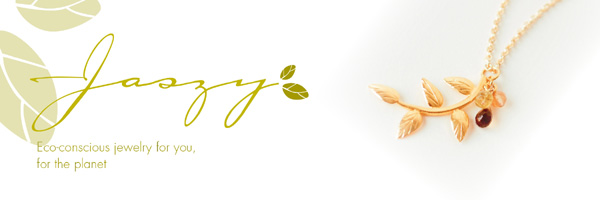Sunday, June 28, 2009
Jaszy ecommerce site!
A huge question is...How important is it to see jewelry on an actual person? Or are general product pics sufficient?
I really appreciate your thoughts and ideas!!
Thursday, June 25, 2009
Shout out in Eco Fahion World!!
eco fashion world's goal is "to keep you green, gorgeous and growing with a comprehensive ecofashion finder of the greatest brands, shops and resources around the globe."
Look to eco fashion world for all the latest ecofashion news and reviews, designer q&a's, store profiles, launch updates, and interviews.
Thank you eco fashion world!
Thursday, June 18, 2009
Spotlight on: Fair Trade Tagua Seeds (Ivory-nut Palm)

The ivory palm endosperm or “tagua” have a similar density and color of elephant ivory, and have often been used as a substitute for making netsuke, scrimshaw and inlay work on furniture and boxes, beads, buttons, figurines, jewelry, and can be dyed. More recently, palm ivory has been used in the production of bagpipes.
Vegetable ivory (tagua) furthers important environmental and socioeconomic goals by stimulating the local economies, provides an alternative to cutting down rainforests for farming, and prevents elephants from being killed for the ivory in their tusks. This is a natural rain forest product that can generate five times the artisan income than banana plantations or cattle ranches. In one year a tagua palm produces the same amount of "ivory" as one female elephant. Tagua nuts are harvested by hand after the ripe fruit has detached without harming the tree.
You can find Fair Trade tagua in many Jaszy’s Jewelry designs accented with gemstones, sterling silver and gold metals.
Sources:
http://en.wikipedia.org/wiki/Tagua
http://waynesword.palomar.edu/pljan99.htm
http://www.3malliance.org/index.php?id=32
For more in-depth information, see blog post http://milenagalapagos.wordpress.com/2007/11/23/ecuadorian-tagua-nuts/
Update: This article was later published on More.com. Click here to view.

Friday, June 12, 2009
Jaszy's Jewelry on Channel 8 News with Gayle Guyardo!
 It's kinda surreal to see yourself on tv and very exciting! I am thrilled that I had this opportunity and so very thankful. Yet, just as surely as the moment came my good friend SR reminded me that the work has just begun. He's right of course, but I'm gonna bask just a bit longer!
It's kinda surreal to see yourself on tv and very exciting! I am thrilled that I had this opportunity and so very thankful. Yet, just as surely as the moment came my good friend SR reminded me that the work has just begun. He's right of course, but I'm gonna bask just a bit longer!Take a gander at my interview with Gayle Guyardo!
Monday, June 8, 2009
What is "Fair Trade"?

Let me preface this post by saying that I am not an environmentalist, although I've been known to hug a few trees...What I am is a naturalist with a general focus on humanitarianism...(long word). In short, I love nature and on most days I love people. I also love designing jewelry. What does all that have to do with "Fair Trade"? For me, striving to combine my love for nature, people and jewelry led me to question how I could ensure that my endeavors would make a difference.
Fair trade is a system of exchange that seeks to create greater equity and partnership in international trading system by paying fair wages in local context, supporting participatory workplaces, ensuring environmental sustainability, supplying financial and technical support, offering public accountability, respecting cultural identity, building direct and long-term relationships, and educating consumers.
By approaching development as a whole process (rather than just a fair price), fair trade organizations cultivate partnerships with their suppliers and contribute to the development of communities. Fair trade is not about charity; it uses a fairer system of exchange to empower producers and to create sustainable, positive change, http://www.fairtradefederation.org.
I believe that by seeking out vendors who adhere to Fair Trade standards, purchasing Fair Trade and ethically sourced materials, and contributing to organizations who spearhead and support these efforts I am able to create and share my passion with a clear conscience.
be well, be positive, be present...
Jaszy

![Reblog this post [with Zemanta]](http://img.zemanta.com/reblog_e.png?x-id=1ba5a0e5-38c7-4d60-8622-c47d87c26a19)
![Reblog this post [with Zemanta]](http://img.zemanta.com/reblog_e.png?x-id=00ba941f-28cd-4a74-aeeb-7bf4c799a0a4)
![Reblog this post [with Zemanta]](http://img.zemanta.com/reblog_e.png?x-id=fe7a1d15-8350-4c11-8ab9-73f9eccba54d)




